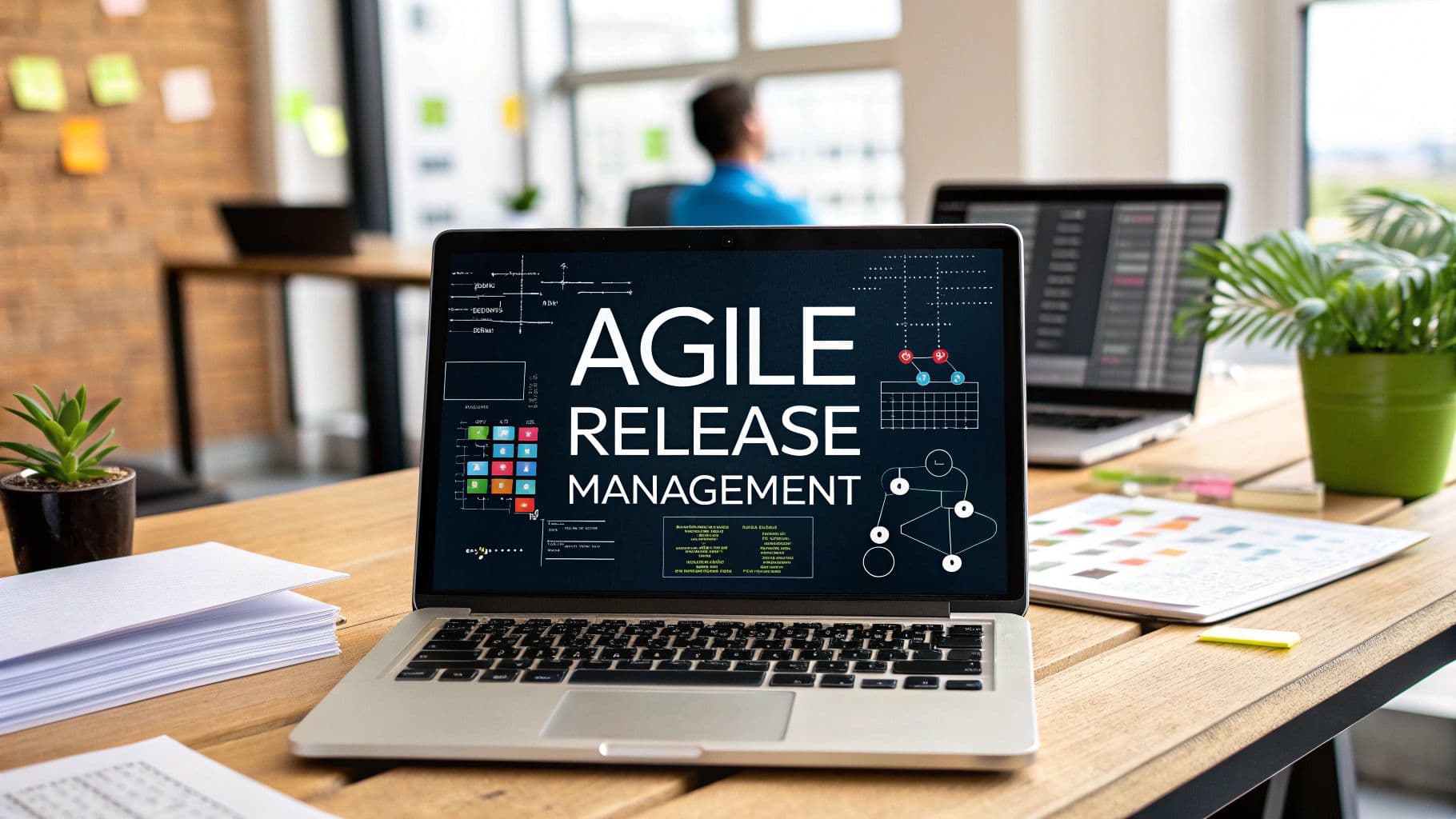speech recognition
speech to text
speech recognition api free
voice recognition
free api
Top Speech Recognition API Free Options in 2025
Unlocking the Power of Voice: Free Speech Recognition APIs in 2025
Need to convert speech to text without emptying your wallet? This listicle showcases the top 8 free speech recognition API options available in 2025. Discover powerful tools, including browser-based APIs and cloud services with generous free tiers, perfect for developers, entrepreneurs, and AI enthusiasts alike. Whether you're prototyping a voice-controlled app or building a full-fledged transcription service, this list provides the free speech recognition API solutions you need. We'll cover Web Speech API, Google Cloud Speech-to-Text, Microsoft Azure Speech Services, AssemblyAI, IBM Watson Speech to Text, Rev.ai, Deepgram, and Vosk.
1. Web Speech API
The Web Speech API stands out as a powerful and completely free speech recognition API readily available within modern web browsers. It eliminates the need for external services, API keys, or server-side processing, making it an incredibly accessible option for developers seeking to integrate speech recognition directly into their web applications. As part of the HTML5 specification, this client-side API empowers you to harness the power of voice interaction and create compelling user experiences directly within the browser. This makes it an ideal choice for those seeking a free and easy-to-implement speech recognition solution. For developers focusing on budget-friendly prototyping or aiming to quickly add basic voice control features, the Web Speech API offers a compelling starting point.

One of the key advantages of the Web Speech API is its real-time continuous speech recognition capability. This allows your web applications to process user speech as it's being spoken, enabling a more natural and interactive experience. This is particularly beneficial for applications like dictation software, live transcription tools, and voice-controlled interfaces, where immediate feedback and responsiveness are essential. Imagine building a real-time captioning system for online meetings or a voice-activated web-based game – the Web Speech API makes such projects feasible without relying on costly external services. The API also supports multiple languages and dialects, broadening the potential user base for your applications.
The Web Speech API integrates seamlessly with JavaScript, making it incredibly easy to incorporate speech recognition into your existing web projects. Developers can readily access and manipulate recognized speech within their JavaScript code, enabling dynamic updates and interactions based on user voice input. For instance, you can use the recognized text to populate form fields, execute specific commands, or trigger other actions within your web application. The straightforward integration with JavaScript empowers developers of all skill levels to quickly implement speech-enabled features. Think of building a simple voice search feature on your website or enabling voice control for a web-based presentation – the Web Speech API provides the necessary tools to achieve these functionalities with minimal effort. Learn more about Web Speech API for further insights into its application in AI-powered note-taking.
Furthermore, the Web Speech API is inherently privacy-focused. Since all processing happens directly within the user's browser, the audio data never leaves their device. This eliminates the need to transmit sensitive voice data to external servers, offering users a greater level of control and security over their personal information. In a world increasingly concerned about data privacy, this client-side processing is a significant advantage.
However, the Web Speech API does have some limitations. Browser support is primarily concentrated on Chrome and Edge, although other browsers are slowly adding or improving their support. Accuracy can also vary between browsers, and the API lacks offline functionality. Customization options are somewhat limited, making it less suitable for highly specialized use cases that require fine-grained control over the speech recognition process. For instance, training the API on specific vocabulary or acoustic models isn't readily available. If your project requires these advanced features, exploring other speech recognition APIs might be necessary.
The Web Speech API requires no specific technical setup beyond a compatible web browser. Simply include the necessary JavaScript code in your web application to access the API's functionality. As it's completely free with no usage limits, API keys, or registration requirements, it offers a low-barrier entry point for developers experimenting with speech recognition technology. It's perfect for quickly prototyping voice-enabled features or building simple web applications that utilize speech input. For more complex projects, it can serve as a valuable starting point for evaluating the feasibility of speech recognition before investing in more advanced (and potentially costly) solutions.
2. Google Cloud Speech-to-Text API
The Google Cloud Speech-to-Text API stands out as a powerful and versatile option for those seeking a high-quality speech recognition api free. Powered by Google's cutting-edge machine learning models, this enterprise-grade service boasts impressive accuracy and supports a vast array of languages and dialects, making it a top contender for various applications. Whether you're a seasoned developer or just starting out, its robust features and generous free tier make it an attractive choice for bringing your speech-to-text projects to life. From transcribing audio files to powering real-time voice interactions, Google's offering caters to a diverse range of needs.
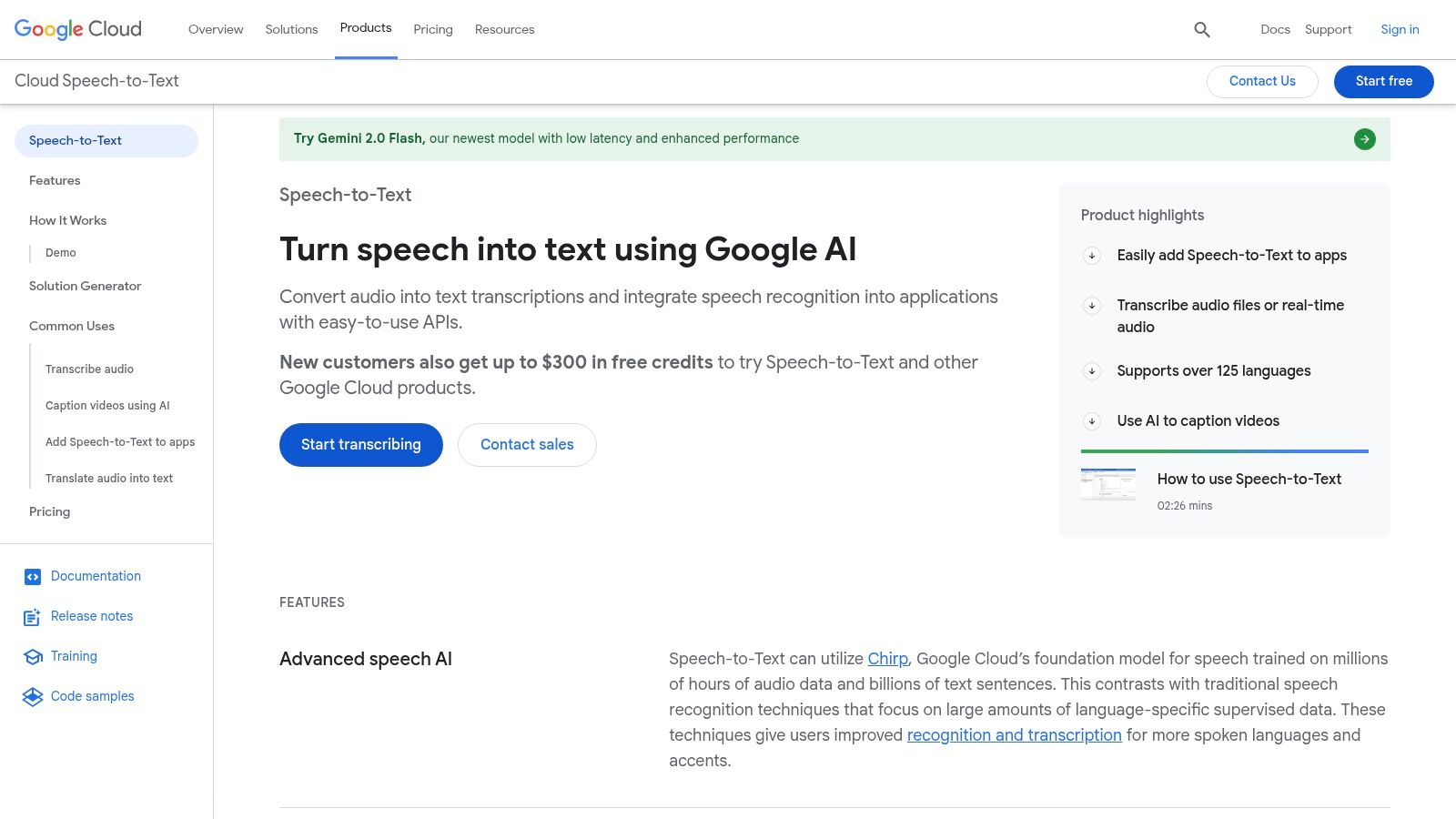
One of the most significant advantages of the Google Cloud Speech-to-Text API is its extensive language support. Covering over 125 languages and variants, it caters to a global audience and makes it suitable for applications requiring multilingual capabilities. This breadth of language support is unparalleled by many other free speech recognition APIs, solidifying its position as a leader in the field. Furthermore, the API excels in accuracy, leveraging advanced machine learning models trained on vast datasets to deliver highly precise transcriptions. This minimizes errors and ensures reliable results, a crucial factor for applications where accuracy is paramount, like medical transcription or legal dictation.
Beyond simple transcription, the API offers a rich set of features designed to enhance the user experience and cater to diverse use cases. These features include real-time streaming for instantaneous transcription, batch processing for handling large volumes of audio data, automatic punctuation and formatting for cleaner output, speaker diarization to identify individual speakers in a conversation, and noise robustness to filter out background noise. This comprehensive suite of tools allows developers to tailor the API to their specific needs and build sophisticated applications with minimal effort. For those seeking even greater control, the API allows for custom model training, enabling you to fine-tune the speech recognition engine for specific vocabulary or audio characteristics, further enhancing accuracy and performance.
The Google Cloud Speech-to-Text API offers a generous free tier, providing 60 minutes of audio processing per month. This is an excellent starting point for developers to experiment with the API, build prototypes, and test their applications without incurring any costs. This free allowance is significantly higher than many competing services, making it particularly appealing to independent developers, hobbyists, and startups. However, it's essential to understand the pricing structure for usage beyond the free tier. While the free tier is generous, exceeding the limit can lead to substantial costs, especially for applications processing large volumes of audio data. The pricing model is based on the duration of the audio processed, with different rates for different features and audio types. It's crucial to carefully evaluate your expected usage and budget accordingly.
Setting up the Google Cloud Speech-to-Text API requires a Google Cloud account. While this process is relatively straightforward, it might present a slight barrier for users unfamiliar with the Google Cloud platform. You'll need to create a project, enable the Speech-to-Text API, and obtain authentication credentials. Detailed documentation and tutorials are available on the Google Cloud website, guiding users through the setup process step-by-step. Once set up, the API can be easily integrated into your applications using various client libraries available for popular programming languages like Python, Java, and Node.js.
Compared to other free speech recognition APIs, Google's offering stands out with its superior accuracy, extensive language support, and comprehensive features. While some open-source solutions might offer more flexibility in terms of customization and deployment, they often lack the robust performance and reliability of Google's enterprise-grade service. Moreover, the generous free tier makes it a more accessible option for smaller projects compared to some paid services that may require upfront subscriptions. However, it's worth noting that an internet connection is required to use the Google Cloud Speech-to-Text API, as it relies on cloud-based processing. This might be a limitation for certain offline applications.
In conclusion, the Google Cloud Speech-to-Text API offers a compelling combination of accuracy, features, and affordability, making it an excellent choice for a wide range of speech recognition applications. Its generous free tier, extensive language support, and advanced features position it as a valuable tool for developers, entrepreneurs, and anyone seeking to harness the power of speech-to-text technology. You can explore the API and its documentation further on the official website: https://cloud.google.com/speech-to-text
3. Microsoft Azure Speech Services
Microsoft Azure Speech Services stands out as a powerful and comprehensive platform for leveraging speech recognition technology, offering a robust free tier ideal for experimentation and small-scale projects. This makes it a compelling option for anyone searching for a "speech recognition api free," whether you're an independent developer, a startup founder, or simply exploring the potential of speech AI. It provides both standard and neural voice models, allowing you to choose the best fit for your specific needs. This flexibility, coupled with a generous free tier, makes Azure Speech Services a valuable resource for a wide range of applications.
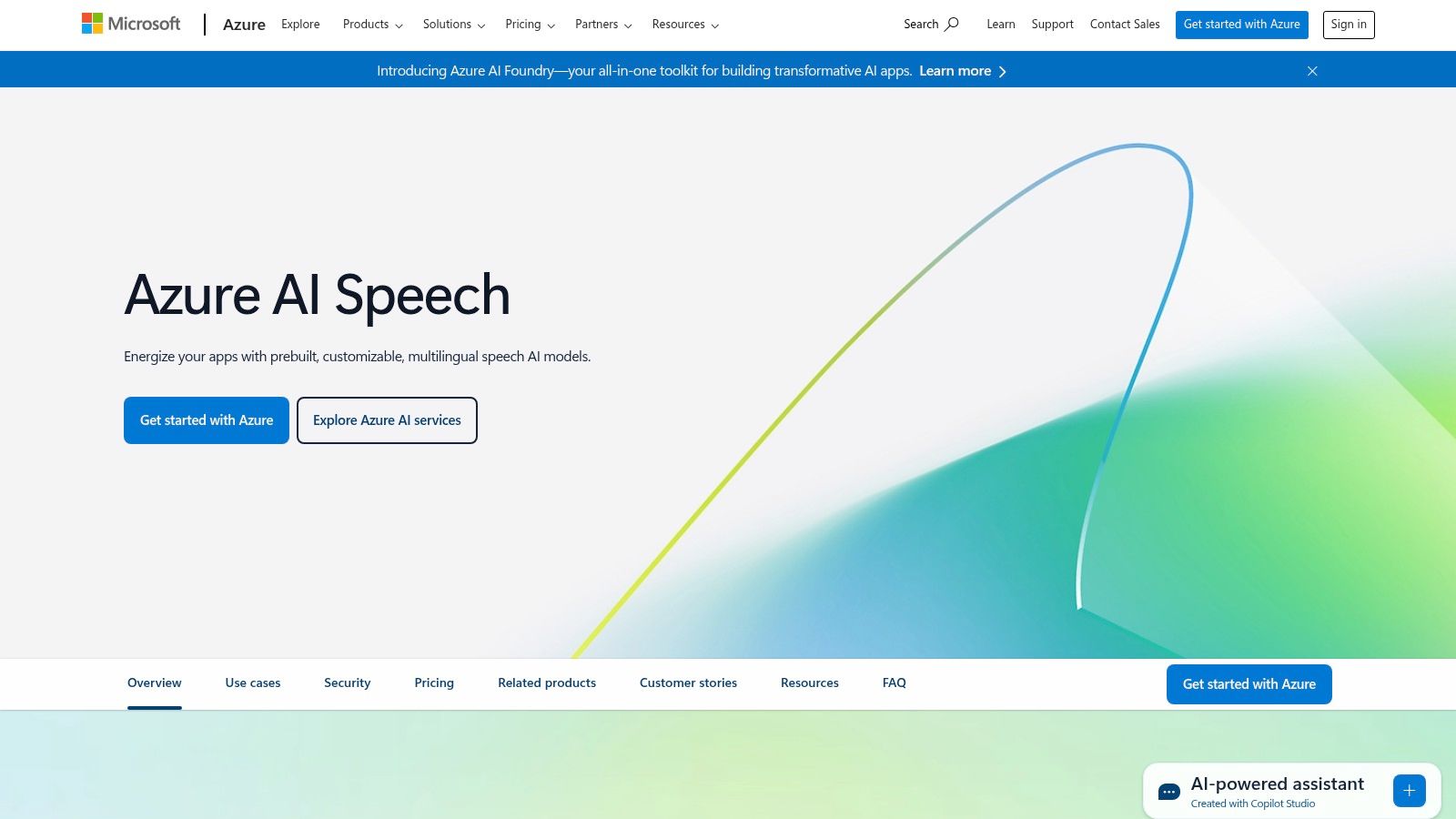
The free tier allows for 5 hours of audio processing per month, which is sufficient for prototyping, testing, and even some light production use cases. Imagine building a voice-controlled home automation system, transcribing interviews for a research project, or creating an interactive voice response system for a small business - all within the limits of the free tier. This makes Azure Speech Services particularly attractive for independent developers, hobbyists, and startups looking to incorporate speech recognition without incurring significant upfront costs.
Beyond the free tier, Azure Speech Services offers a broad spectrum of features. Its neural and standard speech models provide high accuracy and low latency, essential for real-time applications like live captioning and voice assistants. The ability to train custom speech models opens doors for specialized vocabularies and accents, increasing accuracy in niche domains like medical transcription or legal dictation. This customization capability distinguishes Azure Speech Services from more basic free speech recognition APIs, making it suitable for professional applications demanding tailored solutions. Furthermore, the platform seamlessly integrates with other Azure cognitive services, enabling the creation of sophisticated AI-powered solutions that combine speech recognition with other capabilities like language understanding and text-to-speech.
Azure Speech Services supports both real-time transcription and batch processing, catering to different project requirements. Real-time transcription is essential for interactive applications like voice search and dictation, while batch processing is more suitable for transcribing large audio files like lectures or podcasts. This dual functionality provides flexibility for various use cases, from processing live audio streams to analyzing pre-recorded audio content. The included speaker recognition and identification features further expand the potential applications, enabling functionalities like voice authentication and personalized user experiences.
For developers, Microsoft provides comprehensive documentation and SDKs in various programming languages, facilitating seamless integration with existing projects. However, working with Azure Speech Services does require an Azure account and some familiarity with the Azure ecosystem, which might present a learning curve for those new to the platform. While the free tier is generous, understanding the complex pricing structure for usage beyond the free allowance is crucial for budgeting and scaling projects effectively. Also, like any cloud-based service, Azure Speech Services relies on internet connectivity for processing, making offline functionality unavailable.
Getting Started with Azure Speech Services:
- Create an Azure Account: If you don't already have one, sign up for a free Azure account. This will give you access to the free tier of Speech Services.
- Create a Speech Resource: In the Azure portal, navigate to "Create a resource" and search for "Speech." Select "Speech" and click "Create." Choose your desired region, pricing tier (start with the free F0 tier), and resource group.
- Obtain Keys and Endpoint: After deployment, navigate to your Speech resource and locate the "Keys and Endpoint" section. You'll need these credentials to authenticate your API calls.
- Choose an SDK: Download the appropriate SDK for your preferred programming language (Python, C#, Java, etc.).
- Follow the Quickstart Guide: Microsoft provides detailed quickstart guides for each SDK, walking you through the process of making your first API call. These guides typically cover speech-to-text, text-to-speech, and other core functionalities.
Compared to other free speech recognition APIs, Azure Speech Services offers a compelling balance of functionality, generosity, and scalability. While other options may offer simpler integration for basic tasks, Azure's robust features, custom model training, and integration with the wider Azure ecosystem make it a powerful choice for ambitious projects and professional applications. The free tier serves as an excellent entry point, allowing users to explore the capabilities of the platform before committing to paid usage.
4. AssemblyAI
AssemblyAI stands out as a modern and developer-focused speech recognition API free tier, providing an attractive option for those seeking high accuracy and advanced features. Unlike basic transcription services, AssemblyAI goes further by offering sentiment analysis, content moderation, speaker labeling, and more. This makes it a powerful tool for a variety of applications beyond simple dictation. Its commitment to ease of integration, coupled with comprehensive documentation and community support, makes it particularly appealing to developers of all skill levels.

The free tier offered by AssemblyAI grants users 5 hours of transcription per month, which is enough to experiment with the API and build proof-of-concept projects. This allows developers to thoroughly test the API’s capabilities and determine its suitability for their specific needs before committing to a paid plan. For independent developers, hobbyists, and startup founders exploring early-stage ideas, this free allowance can be invaluable. Imagine building a prototype for a voice-controlled smart home device or transcribing user interviews for market research – AssemblyAI’s free tier makes these endeavors accessible without upfront financial investment.
Beyond the basics, AssemblyAI’s strength lies in its advanced AI-powered features. Sentiment analysis allows you to gauge the emotional tone within audio, opening up possibilities for analyzing customer feedback, social media conversations, and even podcast content. Content moderation helps identify potentially inappropriate or offensive language, crucial for platforms dealing with user-generated audio content. Speaker labeling and confidence scores add another layer of sophistication, allowing you to differentiate between multiple speakers in a conversation and understand the certainty of the transcription.
For freelance agencies and consultants, AssemblyAI offers a competitive advantage by enabling them to provide value-added services to their clients. Imagine transcribing client meetings automatically and generating summaries with key takeaways, or analyzing customer service calls to identify areas for improvement. The API’s support for various audio formats also simplifies workflows, eliminating the need for complex format conversions. Webhook integration allows for asynchronous processing, meaning you can submit audio files and receive the transcribed text later, freeing up resources and improving application performance.
While AssemblyAI provides a robust and feature-rich platform, it's essential to consider its limitations. The 5-hour free tier, while generous for initial exploration, is smaller than what major cloud providers like Google or Microsoft offer. This makes AssemblyAI less suitable for large-scale transcription projects without moving to a paid plan. The pricing can escalate quickly for heavy usage, so it's crucial to carefully evaluate your needs and budget. Also, while AssemblyAI boasts excellent documentation and community support, it’s a relatively newer service with less enterprise adoption compared to industry giants. Its language support, while continually expanding, is currently less comprehensive than that of Google or Microsoft.
Setting up AssemblyAI is straightforward. The developer-friendly API design uses standard RESTful principles and provides client libraries for various programming languages, making integration into existing projects seamless. The comprehensive documentation guides developers through the process step-by-step, covering authentication, API endpoints, data formats, and best practices. Learn more about AssemblyAI to understand how it's being used in innovative applications. For those seeking a powerful and easy-to-use speech recognition API with advanced AI capabilities, AssemblyAI deserves its place on this list and provides a compelling alternative to more established players. However, be mindful of the limitations regarding the free tier and long-term pricing before committing to large-scale deployments. Its strength lies in empowering developers to build innovative voice-enabled applications with minimal friction. By leveraging the free tier, developers can experiment, prototype, and validate their ideas before scaling up to a paid plan, making AssemblyAI a valuable tool in the modern developer’s arsenal.
5. IBM Watson Speech to Text
IBM Watson Speech to Text is a robust, enterprise-grade speech recognition API powered by Watson AI. It stands out for its powerful customization capabilities, making it highly suitable for businesses with specialized vocabulary needs. With a generous free tier offering 500 minutes of transcription per month, it's a compelling option for those seeking a powerful yet accessible speech recognition api free solution. This makes it particularly attractive for startups, independent developers, and researchers experimenting with speech-to-text technology. Whether you're building a voice-activated chatbot, transcribing meeting minutes, or analyzing customer interactions, Watson Speech to Text offers the tools and flexibility to bring your speech-based projects to life.

One of the most significant advantages of Watson Speech to Text is its ability to create custom acoustic and language models. This means you can train the API to recognize specific terminology, accents, and even background noise prevalent in your industry or use case. For instance, if you're developing a medical transcription application, you can train the model on medical jargon to significantly improve accuracy. Similarly, legal professionals can tailor the model to understand legal terms, while financial institutions can customize it for financial language. This level of customization sets Watson Speech to Text apart from many other speech recognition api free options, making it a powerful tool for niche applications.
Beyond customization, Watson Speech to Text boasts a comprehensive suite of features. It supports both real-time and batch transcription, offering flexibility depending on your application's requirements. Real-time transcription is ideal for live captioning, voice assistants, and interactive voice response (IVR) systems, while batch transcription is suitable for transcribing large audio files like lectures or podcasts. The API also provides speaker labels, allowing you to distinguish between multiple speakers in an audio recording, and word confidence scores, giving you an estimate of the accuracy of each transcribed word. Furthermore, support for various audio formats, including telephony and broadband audio, ensures compatibility with a wide range of audio sources. Features like smart formatting and profanity filtering add further value, streamlining the post-processing of transcribed text.
For developers, integrating Watson Speech to Text is relatively straightforward. The service is available through the IBM Cloud, and APIs are provided for various programming languages, including Python, Java, and Node.js. However, it's worth noting that the setup and configuration process can be complex, especially for beginners. The user interface of the IBM Cloud platform can feel overwhelming initially, and navigating the various services and settings requires some familiarity with cloud computing concepts.
Compared to other speech recognition APIs like Google Cloud Speech-to-Text and AssemblyAI, Watson Speech to Text offers a substantial free tier. While the free tier is limited to 500 minutes per month, it's sufficient for many prototyping and development needs. However, it's important to consider that Watson Speech to Text supports fewer languages than some competitors, which may be a limiting factor for multilingual applications. Additionally, the IBM Cloud dependency can be a constraint for some users who prefer more platform-agnostic solutions.
Technical Requirements: An IBM Cloud account is required to access Watson Speech to Text. The API interacts with the service through RESTful calls, and various SDKs are available for simplified integration with different programming languages.
Pricing: Beyond the free tier of 500 minutes/month, pricing is based on usage, with different rates for different features and audio types. Details can be found on the IBM Cloud pricing page.
Implementation Tips:
- Start with the IBM Cloud documentation and explore the available tutorials and code samples.
- Leverage the pre-built models for common use cases before diving into custom model training.
- Experiment with the different audio input options and settings to optimize for your specific audio source.
- Consider using the word confidence scores to identify potential transcription errors and improve accuracy.
Despite the complexity of the IBM Cloud platform, Watson Speech to Text remains a powerful and versatile speech recognition API. Its robust customization capabilities, generous free tier, and enterprise-grade features make it a compelling option for a variety of speech-based applications, particularly for those working with specialized vocabulary or requiring a high degree of accuracy. By exploring the available documentation and leveraging its powerful features, developers can unlock the potential of Watson Speech to Text to create innovative and intelligent speech-powered solutions. Visit the IBM Watson Speech to Text website to learn more.
6. Rev.ai
Rev.ai stands out as a robust speech recognition API free option specifically designed for users demanding high accuracy. Unlike some free tiers that prioritize basic transcription, Rev.ai balances a usable free tier with features typically found in premium services. This makes it a compelling choice for users working with complex audio or specialized vocabulary, particularly in fields like media, legal, or business. If you’re looking for a free speech recognition API solution that doesn't compromise on quality, Rev.ai is definitely worth considering. It seamlessly blends automated speech recognition with the option for human intervention, allowing you to tailor the service to your specific needs and budget.
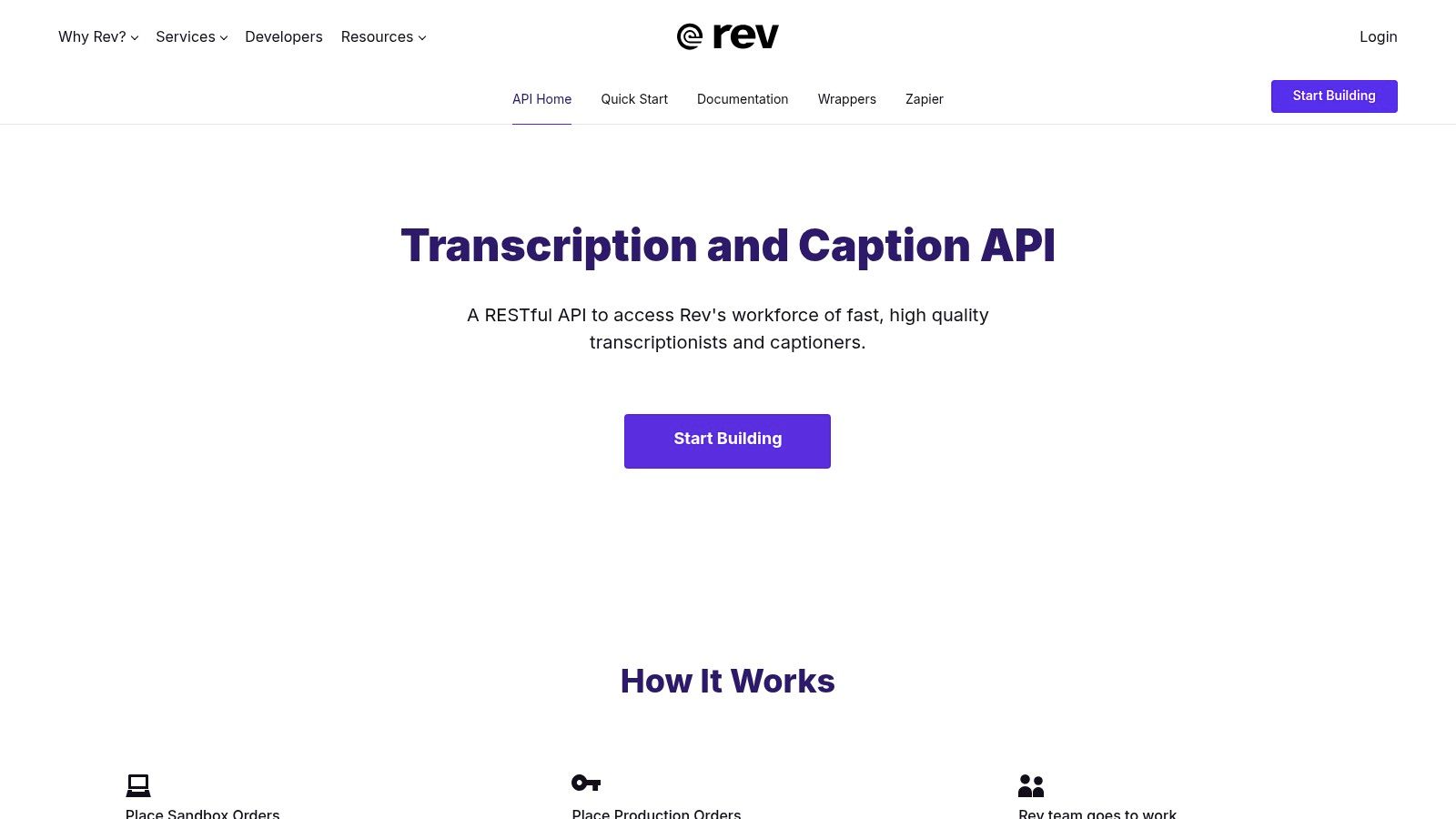
The free tier offers 5 hours of audio transcription per month, a generous offering compared to many competitors. This allows developers and businesses to experiment with the API and even handle moderate-sized projects without incurring any costs. The asynchronous transcription mode is particularly beneficial for processing longer audio files, such as recordings of meetings, lectures, or interviews. Rev.ai’s specialization in professional use cases shines through in its features like custom vocabulary and formatting options. Users can tailor the transcription output to their specific needs, improving accuracy and efficiency in handling jargon, technical terms, or specific formatting conventions.
For startup founders exploring minimum viable products (MVPs) involving voice interaction, Rev.ai's free tier offers a risk-free way to test and iterate. Freelance agencies and consultants working with clients in media or legal domains will appreciate the high accuracy and specialized vocabulary features. Product managers can leverage Rev.ai to quickly prototype voice-enabled features for their applications. AI enthusiasts and prototypers can explore the capabilities of a sophisticated speech recognition engine without significant financial investment.
The inclusion of both asynchronous and streaming transcription modes caters to different use cases. Asynchronous transcription is ideal for offline processing of longer audio files, providing high-accuracy results. Streaming transcription, although not as robust as some dedicated real-time solutions, is suitable for applications that require near real-time transcription, such as live captioning or voice assistants.
Rev.ai provides detailed documentation and good customer support, making it easy to get started and troubleshoot any issues that may arise. This is a crucial factor for independent developers and hobbyists who may require assistance with implementation. The API integrates with popular platforms and tools, simplifying the integration process into existing workflows. While the ecosystem might not be as extensive as those of major cloud providers, it still covers many common use cases.
One of the main advantages of Rev.ai is its hybrid approach. Users can opt for fully automated transcription powered by their AI engine or choose to have human transcribers review and refine the output for even greater accuracy. This flexibility allows for a trade-off between cost and accuracy, catering to diverse needs and budgets. For projects demanding the highest levels of accuracy, such as legal transcriptions or sensitive interviews, the option to upgrade to human review is invaluable.
However, Rev.ai does have certain limitations. The real-time capabilities are not as comprehensive as those offered by major cloud providers like Google Cloud Speech-to-Text or Amazon Transcribe. While streaming transcription is available, it might not be the optimal solution for latency-sensitive applications. The pricing for premium features, including human transcription, can be relatively high compared to some competitors. For simple applications requiring basic transcription, Rev.ai's feature set might be overkill, and more cost-effective solutions might be available. Also, the ecosystem and integration options, while decent, are not as extensive as those of larger cloud providers.
Rev.ai offers a compelling free tier for developers and businesses seeking high-accuracy speech recognition. The 5-hour free allowance provides ample opportunity to explore its features and assess its suitability for various projects. By combining automated transcription with optional human review, Rev.ai offers a flexible and powerful solution that caters to a wide range of needs and budgets. Visit the Rev.ai API website at https://www.rev.com/api for more information and to get started.
7. Deepgram
Deepgram stands out as a next-generation speech recognition API free option, leveraging the power of deep learning to deliver highly accurate and low-latency transcriptions. It's an excellent choice for developers seeking a robust solution for various audio processing needs, especially in challenging audio conditions. While other speech recognition APIs often struggle with noisy backgrounds, accents, or technical jargon, Deepgram excels, making it a powerful tool for demanding applications. Its focus on challenging audio makes it particularly appealing for tasks like transcribing conference calls, analyzing audio from noisy environments, or processing audio with diverse accents. This makes Deepgram an ideal choice for developers seeking a free speech recognition API that can handle complex audio scenarios with greater precision. Learn more about Deepgram
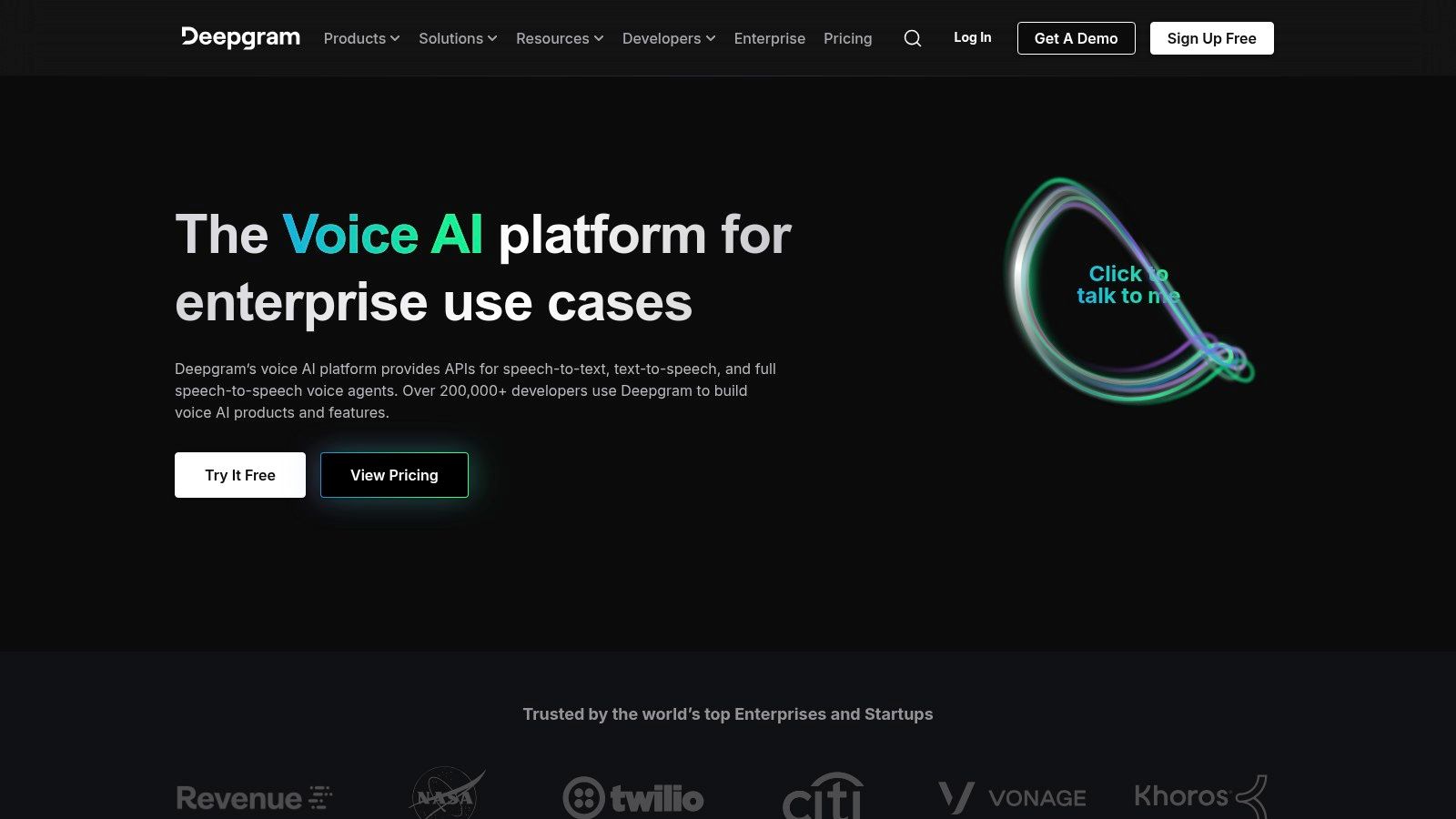
Deepgram’s generous offering of $200 in free credits allows developers to thoroughly test and experiment with the API before committing to a paid plan. This is particularly beneficial for startups and hobbyists looking to build prototypes or explore the potential of speech recognition without upfront financial investment. The free credits allow for extensive experimentation with various audio types and configurations, giving developers a comprehensive understanding of Deepgram's capabilities.
One of Deepgram’s key strengths lies in its real-time streaming capabilities with ultra-low latency. This is crucial for applications that demand immediate feedback, such as live captioning, real-time transcription of meetings, or interactive voice response systems. Imagine building a live transcription tool for online meetings; Deepgram's low latency ensures that the transcribed text appears almost instantaneously, providing a seamless and engaging user experience.
Deepgram offers pre-trained models tailored to specific industries like healthcare, finance, and contact centers. This allows developers to quickly integrate speech recognition into their applications without the need for extensive model training. For example, a healthcare provider could use a pre-trained model to transcribe medical dictations accurately, saving time and resources. Additionally, Deepgram's custom model training capabilities empower developers to fine-tune models for highly specialized needs, achieving even higher accuracy for niche applications. This flexibility makes it a versatile tool for a wide range of projects, from general transcription to specialized audio analysis.
Features like diarization (identifying different speakers in a conversation) and automatic punctuation further enhance the usability of Deepgram's transcripts. These features are especially beneficial for applications like meeting summarization and analysis, where distinguishing between speakers and having properly punctuated text is crucial. Imagine analyzing a customer service call; Deepgram can not only transcribe the conversation but also identify the customer and agent, and punctuate the dialogue for better readability and analysis.
While Deepgram boasts many advantages, it's important to consider its limitations. The credit-based system, while offering substantial initial free usage, can be less predictable than a time-based free tier. Careful monitoring of credit usage is necessary to avoid unexpected costs. The platform is also relatively new, resulting in a smaller community and potentially fewer readily available resources compared to more established providers. Furthermore, while Deepgram’s language support is growing, it currently offers a more limited selection compared to industry giants like Google or AWS. Finally, greater transparency in pricing details beyond the initial free credits would be beneficial for developers planning long-term projects.
Deepgram offers a modern API design with excellent developer experience, allowing for seamless integration into various applications. The comprehensive documentation and SDKs make it easy for developers to get started and quickly implement speech recognition functionalities. From Python and Node.js to Java and Go, developers can leverage their preferred language to integrate Deepgram into their workflows.
For developers seeking a powerful and flexible speech recognition API free trial, Deepgram offers a compelling option. Its strengths in handling challenging audio, real-time streaming, and customizable models make it a valuable tool for a wide range of applications. While the credit-based system and smaller community may pose some considerations, the $200 free credit offering and powerful features make it well worth exploring. Visit the Deepgram website to delve deeper into its features and documentation.
8. Vosk
Vosk stands out as a powerful and versatile option in the realm of free speech recognition APIs. It's a unique offering because it's entirely offline, open-source, and boasts impressive speed and accuracy. This makes it particularly attractive for privacy-conscious developers, those working in offline environments, or those building applications for resource-constrained devices like embedded systems or mobile apps. If your project requires a free speech recognition API and offline functionality is a priority, Vosk is definitely worth exploring.
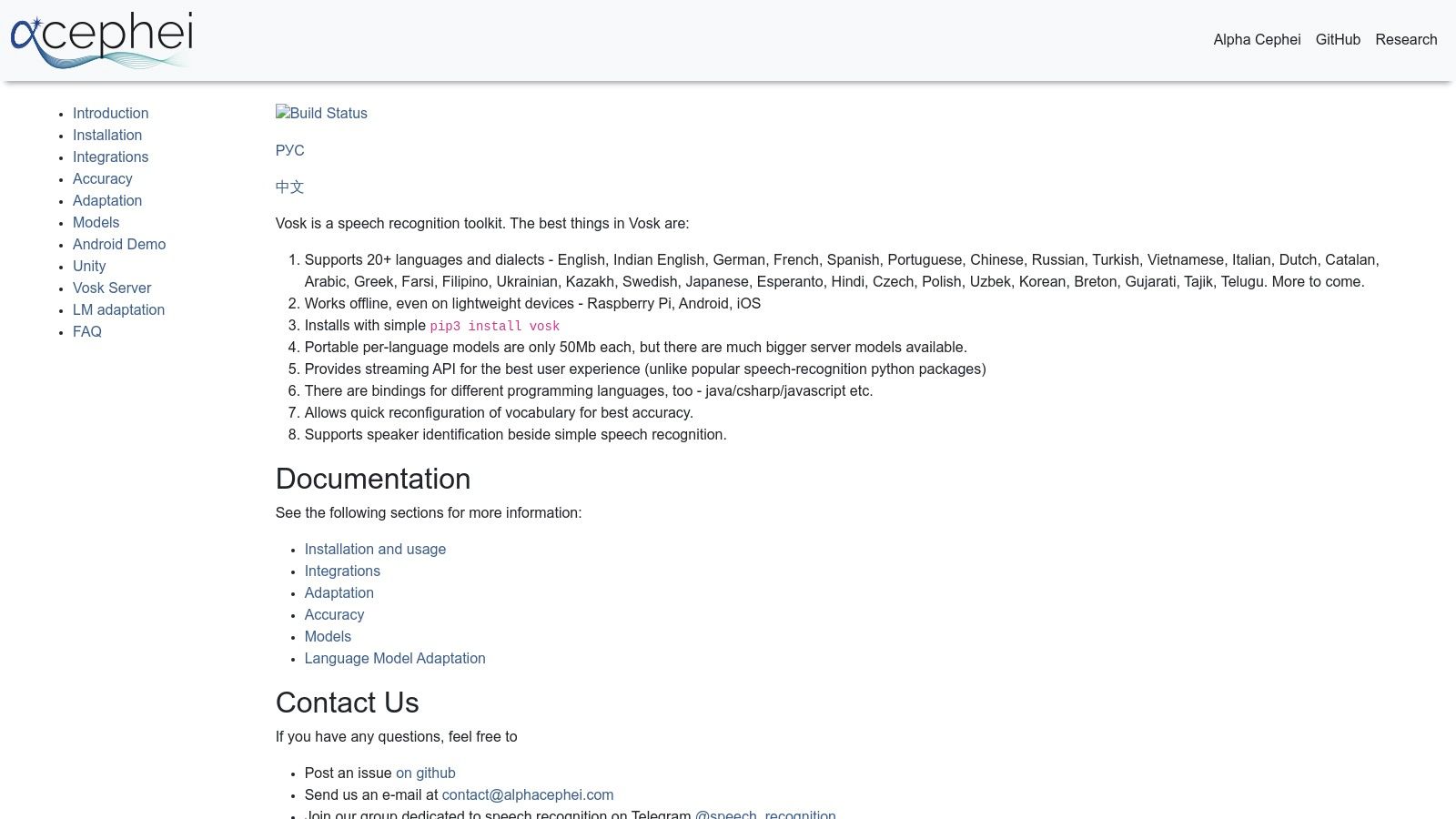
Vosk shines where other free speech recognition APIs fall short: offline functionality. Unlike cloud-based solutions that require a constant internet connection and send your audio data to external servers, Vosk processes everything locally. This eliminates network latency, reduces dependence on third-party services, and most importantly, keeps your user's audio data private and secure. This privacy-centric approach is a significant advantage for applications dealing with sensitive information, or those operating in environments with limited or no internet connectivity.
The toolkit supports over 20 languages, catering to a diverse range of applications and user bases. Pre-trained models are readily available for these languages, simplifying the setup process and allowing developers to quickly integrate speech recognition into their projects. While cloud-based solutions often boast more extensive language support and more frequent model updates, Vosk provides a solid foundation for many common languages, making it suitable for a wide variety of projects.
Vosk is designed with efficiency in mind. Its lightweight models are optimized for mobile and embedded devices, ensuring minimal resource consumption. This allows for smooth real-time speech recognition on even less powerful hardware. Whether you're building a voice-controlled application for a Raspberry Pi, a mobile app with offline voice commands, or integrating speech recognition into a robotics project, Vosk’s lightweight architecture allows for efficient performance without sacrificing accuracy. You can choose between real-time processing for interactive applications or batch processing for transcribing large audio files, offering flexibility depending on your project's needs.
Integration is straightforward thanks to support for multiple programming languages, including Python, Java, C#, and more. This wide range of supported languages makes it accessible to a larger developer community and allows you to seamlessly integrate Vosk into existing projects regardless of the chosen technology stack. Clear documentation and active community support further simplify the integration process.
Vosk – Practical Applications and Use Cases:
- Offline Voice Assistants: Create voice-activated controls for smart home devices, robots, or any application where internet access is unreliable or unavailable.
- Mobile Apps with Offline Speech Recognition: Integrate voice commands or dictation features into mobile apps without relying on cloud services.
- Transcription of Audio Recordings: Transcribe lectures, interviews, or other audio content locally and securely.
- Embedded Systems: Add voice control to embedded systems and IoT devices.
- Accessibility Tools: Develop assistive technologies with voice control for users with disabilities.
Pricing and Technical Requirements:
Vosk is entirely free and open-source, licensed under Apache 2.0. You can download the source code, pre-trained models, and documentation from their official website (https://alphacephei.com/vosk/). The technical requirements depend on the chosen platform and programming language. Generally, you’ll need to install the Vosk library and download the appropriate language model for your project.
Comparison with Similar Tools:
Compared to cloud-based solutions like Google Cloud Speech-to-Text or AssemblyAI, Vosk offers superior privacy and offline functionality but may have slightly lower accuracy for some languages. Other open-source solutions like Mozilla DeepSpeech offer similar offline capabilities but may not be as lightweight or as readily integrated with different programming languages.
Implementation Tips:
- Start with the official documentation and tutorials for your chosen programming language.
- Experiment with different acoustic models to find the best performance for your specific use case.
- Consider using a noise reduction library for improved accuracy in noisy environments.
While Vosk might have some limitations in terms of accuracy compared to some cloud-based options, and may require a bit more technical setup, the benefits of its completely free, offline, and open-source nature make it a compelling choice for many speech recognition projects. Especially for developers prioritizing privacy, offline functionality, and cost-effectiveness, Vosk offers a powerful and flexible toolkit for integrating high-quality speech recognition into a diverse range of applications.
Free Speech Recognition APIs Comparison
| Solution | Core Features | User Experience ★★★★☆ | Value 💰 | Target Audience 👥 | Unique Selling Points ✨ |
|---|---|---|---|---|---|
| Web Speech API | Client-side, real-time, multi-language | ★★★☆☆ Free, privacy-focused | ★★★★★ Completely free | Web developers, privacy-conscious | ✨ No API keys, fully client-side |
| Google Cloud Speech-to-Text | 125+ languages, real-time & batch | ★★★★★ High accuracy, robust | ★★★☆☆ Free tier + pay-as-you-go | Enterprises, global apps | 🏆 Advanced ML, speaker diarization |
| Microsoft Azure Speech | Neural models, custom training, integration | ★★★★☆ Neural voices, enterprise ready | ★★★☆☆ Generous free tier | Enterprises, Azure users | 🏆 Strong Azure ecosystem integration |
| AssemblyAI | Sentiment analysis, content moderation | ★★★★☆ Developer-friendly API | ★★★☆☆ 5 hrs free, advanced features | Developers, startups | ✨ Sentiment & moderation beyond transcription |
| IBM Watson Speech to Text | Industry customization, real-time & batch | ★★★★☆ Enterprise-grade, secure | ★★★☆☆ 500 mins free | Enterprises, industry-specific | 🏆 Custom models for specialized domains |
| Rev.ai | Hybrid AI-human, specialized vocabulary | ★★★★☆ High accuracy, pro features | ★★★☆☆ Free tier with paid upgrades | Media, legal, business pros | ✨ Human transcription option, customized vocab |
| Deepgram | Low latency, custom models, noisy audio | ★★★★☆ Fast, modern API | ★★★☆☆ $200 free credits | Developers, challenging audio | 🏆 Excellent for poor-quality audio, low latency |
| Vosk | Offline, multi-language, lightweight | ★★★☆☆ Free, local processing | ★★★★★ Fully open-source, free | Privacy-focused, embedded devices | ✨ Completely offline, multi-language support |
Choosing the Right Free Speech Recognition API
Finding the perfect free speech recognition API requires careful consideration of your project's unique requirements. We've explored a variety of options, from the browser-native Web Speech API to powerful cloud-based solutions like Google Cloud Speech-to-Text, Microsoft Azure Speech Services, AssemblyAI, IBM Watson Speech to Text, Rev.ai, Deepgram, and the offline functionality of Vosk. Each offers distinct advantages in terms of accuracy, supported languages, free tier usage limits, and ease of integration. Remember to prioritize factors like the specific features you need, the platform you're developing on, and the anticipated scale of your project when making your decision.
Key takeaways include understanding the limitations of free tiers, the importance of accurate transcription for your use case, and the potential benefits of offline solutions like Vosk for privacy-sensitive applications. For straightforward projects, the Web Speech API might suffice. However, for more demanding applications requiring advanced features or higher accuracy, exploring the free tiers of cloud-based speech recognition API free services is crucial.
Selecting the most suitable speech recognition API free for your needs empowers you to create innovative, voice-enabled applications. Accurate and reliable speech-to-text functionality can unlock a new level of user interaction and accessibility. Looking to jumpstart your project and bypass complex integrations? Explore AnotherWrapper, a Next.js powered toolkit providing customizable, ready-to-launch AI applications, including speech-to-text projects, enabling you to go to market faster. Visit AnotherWrapper to discover how you can quickly integrate and customize speech recognition into your application today.
Fekri


